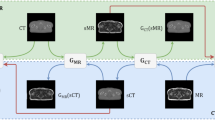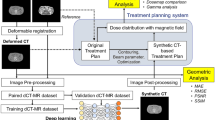Abstract
Deep learning models are increasingly used to generate synthetic images. Synthetic CTs (sCTs) generated from on-treatment cone-beam CTs (CBCTs) hold potential for adaptive radiotherapy, promising a high-quality representation of daily anatomy without requiring additional imaging or dose to the patient. However, validating sCT is very challenging as an accurate and appropriate ground truth is hard to come by in medical imaging. Current global metrics in the literature fail to provide a complete picture of how accurate synthetic images are. We introduce a novel method to evaluate sCTs utilising global error assessment and a local, voxel-wise statistical assessment of the sCT and the current ground truth, a deformably registered CT (dCT). Our methodology allows for the identification of individual cases where the sCT might offer an improved representation of the daily anatomy due to changes that occur over time, as well as showing regions where either the model or image registration under-performs. Our methodology can be used to guide future model development to improve the mapping between modalities, and also assist in deciphering when it is most appropriate to choose a sCT for image guided radiotherapy over the existing standard, the dCT.
Access this chapter
Tax calculation will be finalised at checkout
Purchases are for personal use only
Similar content being viewed by others
References
Boulanger, N., et al.: Deep learning methods to generate synthetic CT from MRI in radiotherapy: A literature review. Physica Med. 89, 265–281 (2021). https://doi.org/10.1016/j.ejmp.2021.07.027
Eckl, M., et al.: Evaluation of a cycle-generative adversarial network-based cone-beam CT to synthetic CT conversion algorithm for adaptive radiation therapy. Physica Med. 80, 308–316 (2020). https://doi.org/10.1016/j.ejmp.2020.11.007
Jaffray, D.A., Siewerdsen, J.H., Wong, J.W., Martinez, A.A.: Flat-panel cone-beam computed tomography for image-guided radiation therapy. Int. J. Radiat. Oncol. Biol. Phys. 53, 1337–1349 (2002). https://doi.org/10.1016/S0360-3016(02)02884-5
Kida, S., et al.: Visual enhancement of Cone-beam CT by use of CycleGAN. Med. Phys. 47, 998–1010 (2020). https://doi.org/10.1002/mp.13963
Kurz, C., et al.: CBCT correction using a cycle-consistent generative adversarial network and unpaired training to enable photon and proton dose calculation. Phys. Med. Biol. 64 (2019). https://doi.org/10.1088/1361-6560/ab4d8c
Liang, X., et al.: Generating synthesized computed tomography (CT) from cone-beam computed tomography (CBCT) using cyclegan for adaptive radiation therapy. Phys. Med. Biol. 64 (2019). https://doi.org/10.1088/1361-6560/ab22f9
Liu, Y., et al.: CBCT-based synthetic CT generation using deep-attention cycleGAN for pancreatic adaptive radiotherapy. Med. Phys. 47, 2472–2483 (2020). https://doi.org/10.1002/mp.14121
Maspero, M., et al.: A single neural network for cone-beam computed tomography-based radiotherapy of head-and-neck, lung and breast cancer. Phys. Imaging Radiat. Oncol. 14, 24–31 (2020). https://doi.org/10.1016/J.PHRO.2020.04.002
Szmul, A., et al.: Developing a framework for CBCT-to-CT synthesis in paediatric abdominal radiotherapy. In: Conference on Medical Image Understanding and Analysis (2021)
Yang, B., et al.: A comparison study between CNN-based deformed planning CT and CycleGAN-based synthetic CT methods for improving iCBCT image quality. Front. Oncol. 12, 2339 (2022). https://doi.org/10.3389/FONC.2022.896795
Zhu, J.Y., Park, T., Isola, P., Efros, A.A.: Unpaired image-to-image translation using cycle-consistent adversarial networks. In: Proceedings of the IEEE International Conference on Computer Vision 2017, pp. 2242–2251 (2017). https://doi.org/10.1109/ICCV.2017.244
Acknowledgements
This research was supported by NIHR Manchester Biomedical Research Centre, Elekta AB, and CRUK Manchester Centre.
Author information
Authors and Affiliations
Corresponding author
Editor information
Editors and Affiliations
Rights and permissions
Copyright information
© 2022 The Author(s), under exclusive license to Springer Nature Switzerland AG
About this paper
Cite this paper
Sargeant, C. et al. (2022). A Novel Method Combining Global and Local Assessments to Evaluate CBCT-Based Synthetic CTs. In: Zhao, C., Svoboda, D., Wolterink, J.M., Escobar, M. (eds) Simulation and Synthesis in Medical Imaging. SASHIMI 2022. Lecture Notes in Computer Science, vol 13570. Springer, Cham. https://doi.org/10.1007/978-3-031-16980-9_12
Download citation
DOI: https://doi.org/10.1007/978-3-031-16980-9_12
Published:
Publisher Name: Springer, Cham
Print ISBN: 978-3-031-16979-3
Online ISBN: 978-3-031-16980-9
eBook Packages: Computer ScienceComputer Science (R0)





